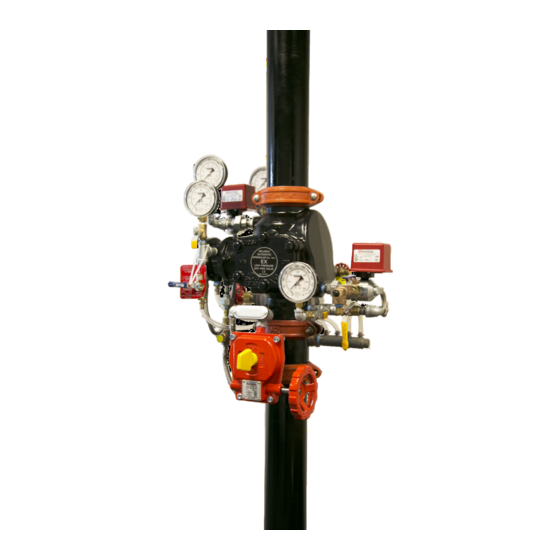
Table of Contents
Advertisement
Quick Links
Features
•
Redundant Solenoid Valve Release
•
Externally Resetable Clapper
•
One Main Drain
Product Description
Reliable Single Interlock Preaction Systems are designed for
water-sensitive areas that require protection from inadvertent
water flow into the sprinkler system piping. A single event, the
activation of the electrical detection system, causes the valve
to operate and flow water into the piping network.
Sprinkler piping in single interlock systems can effectively
be supervised by means of the Reliable Model A Pressure
Maintenance Device (provided) and a tank-mounted air
compressor. Loss of supervising pneumatic pressure, due to
a damaged sprinkler or sprinkler pipe will not cause water to
flow through the Model EX Valve and into the system piping. A
significant loss of pneumatic pressure will activate a trouble-
annunciating device when the system pressure falls below a
predetermined pressure level.
The system incorporates two normally closed solenoid valves
on the releasing trim. These solenoid valves, when closed,
retain sufficient AIR pressure on the pneumatic actuator, which
in turn preserves sufficient WATER pressure in the push rod
chamber of the Model EX Valve in order to maintain it closed.
When the electrical detection system senses the presence of
fire, the electrical releasing control panel activates fire alarm
devices and energizes the two redundant, normally-closed
solenoid valves into the open position.
Energizing the solenoid valves relieves the air pressure on the
pneumatic actuator, thereby releasing the water pressure that
it was retaining. This in turn relieves the pressure in the push
rod chamber of the Model EX Valve. Venting the push rod
chamber will open the Model EX Valve and allow water to flow
into the sprinkler system.
Water flowing into the sprinkler system piping will
simultaneously produce water pressure that causes the
transfer of contacts in the pressure switch mounted in the trim.
Valve Size
2" (50mm), 2-1/2" (65mm), 76mm &
3" (80mm)
4" (100mm)
6" (150mm) & 165mm
8" (200mm)
Availability: UK
This pressure switch can electrically initiate the shutdown or
startup of equipment, such as computers or other second
alarm devices. The flow of water into the sprinkler system
piping effectively converts the dry system into a wet pipe
system. In the event that the fire subsequently produces
sufficient heat to operate a fire sprinkler, water will flow from
that sprinkler, controlling or suppressing the fire.
The major benefits of a single interlock preaction system,
when compared with a wet pipe (deluge) system are as
follows:
1.
A fire alarm sounds prior to the operation of a sprinkler,
which may enable extinguishing the fire by handheld
means before the actual operation of any sprinklers and
subsequent water damage.
2.
A trouble annunciator signals whenever the integrity of
the piping or sprinklers is accidentally or intentionally
disturbed; however, no water flow or water damage will
occur at that time.
3.
Speedy detection and an early fire alarm are provided
by fire detectors, without the delay associated with water
flow detection in the event of a fire. Note: with a wet pipe
system, the fire alarm is delayed until after water has
begun flowing from an operated sprinkler.
End Connection
Groove/ Groove
Groove/ Groove
Flange/ Groove
Flange/ Flange
Groove/ Groove
Flange/ Groove
Flange/ Flange
Groove/Groove
Flange/Flange
www.reliablesprinkler.com
Bulletin 739 June 2020
Model EX Single Interlock
Preaction Type A (LPCB)
2", 2-1/2", 76mm, 3", 4", 6", 165mm, & 8"
Approx. Shipping Weight
44lbs (20kg)
74lbs (34kg)
105lbs (48kg)
158lbs (72kg)
Table A
Advertisement
Table of Contents

Summary of Contents for Reliable EX
- Page 1 Loss of supervising pneumatic pressure, due to a damaged sprinkler or sprinkler pipe will not cause water to flow through the Model EX Valve and into the system piping. A This pressure switch can electrically initiate the shutdown or...
- Page 2 Model EX Single Interlock Preaction System Type A Technical Data Listings and Approvals Technical Specifications Pressure Rating: LPCB 175 psi (12,1 bar) Minimum Water Supply Pressure: End Connections 20psi (1,4 bar) See Table A Minimum Water Supply Temperature: Specifications 40°F (4°C)
-
Page 3: System Operation
Model EX Valve. This valve is a hydraulically operated, straight- Water from the supply flows through the EX Valve into the system through-design, differential-type valve (see Fig. 2). System piping. Water also flows through the dry pipe alarm outlet to the maintenance is simplified since priming water is not required and alarm devices. -
Page 4: System Design Considerations
Note: During the initial system set-up, a higher pneumatic pressure may be required in order to properly seat the internal diaphragm of the pneumatic actuator. Refer to Reliable Bulletin 251 for instructions on how to modify these pressure settings. Friction Loss... - Page 5 Single Interlock Preaction System Air Pressure Settings Figure 3 Bulletin 739 Page 5 of 9 June 2020 www.reliablesprinkler.com...
- Page 6 Model EX Type A Components Figure 4 Bulletin 739 Page 6 of 9 June 2020 www.reliablesprinkler.com...
-
Page 7: Inspection And Testing
Model EX Valve clapper. Verify that valve supplying hydraulic pressure to the piston/ 16. Open the alarm line valve. If no leak occurs, the Model EX pushrod chamber is open, allowing water to enter the Valve clapper is sealed. -
Page 8: Maintenance
Water leaking from Ball Drip. This can be caused by either a water column on top of The Reliable Model EX valve and associated equipment shall the clapper or a supply water leakage. periodically be given a thorough inspection and test. NFPA a. -
Page 9: Listing & Approvals
Align the mounting ring so that the Lever is near of 15 foot-pounds in a star pattern. Set up the Model EX Valve the pushrod and the mounting ring “ears” are between as per the section “Resetting Model EX Valve Single Interlock...





Need help?
Do you have a question about the EX and is the answer not in the manual?
Questions and answers